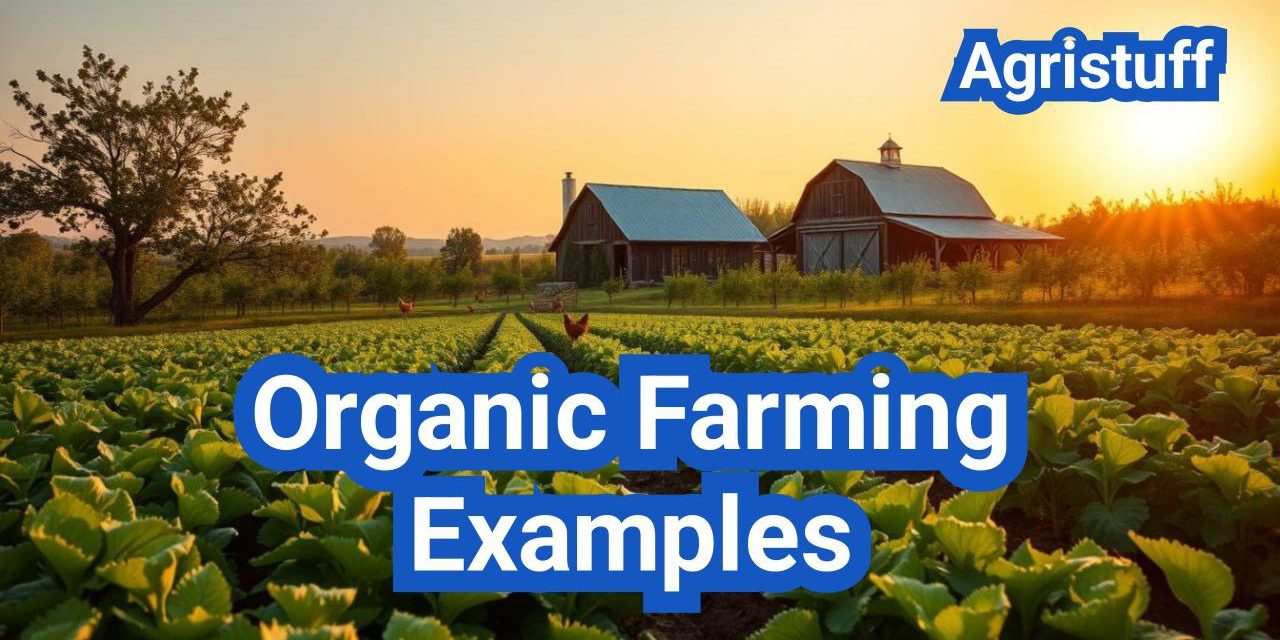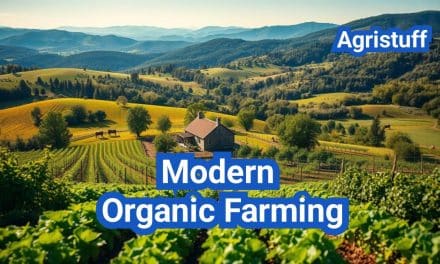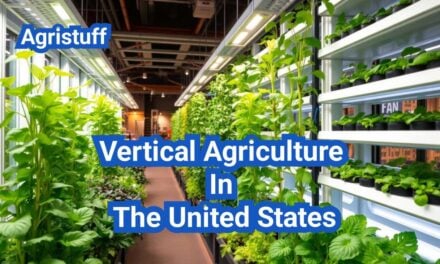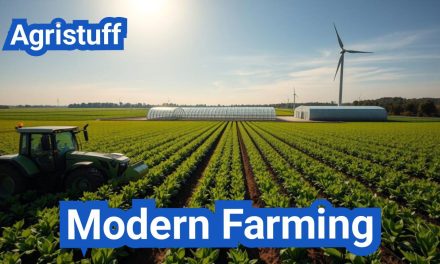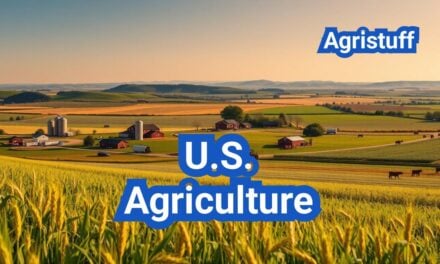Sustainable agriculture is gaining traction worldwide as a viable alternative to conventional farming methods.
Organic farming is an agricultural system that emphasizes the use of naturally occurring, non-synthetic inputs to maintain soil health, conserve water, and promote biodiversity.
This approach to farming practices not only ensures the long-term sustainability of the land but also produces healthier crops and livestock.
As the demand for sustainable produce continues to grow, understanding the principles and benefits of organic farming is crucial for farmers, consumers, and the environment alike.
Key Takeaways
- Agricultural sustainability is crucial for long-term land viability.
- Organic farming promotes soil health, conserves water, and promotes biodiversity.
- Sustainable farming practices produce healthier crops and livestock.
- Growing demand for sustainable produce drives the need for organic farming.
- Understanding organic farming principles is essential for farmers and consumers.
The Fundamentals of Organic Farming
The core of organic farming lies in its adherence to sustainable practices that promote environmental health. Organic farming is built on a set of principles that prioritize natural processes and biodiversity.
Key Organic Farming Standards and Practices
Organic farming standards prohibit the use of synthetic pesticides, fertilizers, and genetically modified organisms (GMOs). These standards ensure that organic farming practices are environmentally friendly and sustainable. Organic farming methods focus on using natural materials and processes to maintain soil fertility and control pests.
Environmental and Health Benefits of Organic Methods
Organic farming offers numerous environmental and health benefits. By avoiding synthetic chemicals, organic farming reduces the risk of soil, water, and air pollution. This approach also promotes soil health and biodiversity.
Soil Health Improvements
Organic farming practices like crop rotation, composting, and cover cropping enhance soil fertility and structure. These methods improve soil’s water-holding capacity and reduce erosion. Healthy soil is crucial for sustainable agriculture and ecosystem services.
Biodiversity Enhancement
Organic farming systems often have higher biodiversity compared to conventional farming methods. By maintaining ecological balance, organic farming promotes the presence of beneficial insects, birds, and other wildlife. This biodiversity is essential for long-term agricultural productivity and ecosystem resilience.
In conclusion, the fundamentals of organic farming are rooted in sustainable practices that benefit both the environment and human health. By adhering to organic farming standards and practices, farmers can contribute to a healthier ecosystem.
Successful Organic Farming Examples Across America
The United States is home to a diverse range of organic farming operations, from small urban plots to large commercial enterprises. These examples showcase the versatility and potential of organic farming methods across different scales and regions.
Small-Scale Urban Farms
Urban farming has become increasingly popular in cities across America. These small-scale operations often utilize innovative techniques such as vertical farming and hydroponics to maximize space and productivity. Urban organic farms not only provide fresh produce to local communities but also serve as educational hubs, promoting sustainable practices.
Mid-Size Diversified Operations
Mid-size diversified organic farms offer a mix of crops and sometimes livestock, enhancing biodiversity and farm resilience. These operations often employ crop rotation, cover cropping, and integrated pest management to maintain soil health and minimize environmental impact. Diversified farming systems are better equipped to withstand climate variability and market fluctuations.
Large Commercial Organic Enterprises
Large commercial organic farms play a significant role in meeting the growing demand for organic produce. These enterprises often leverage advanced technology and economies of scale to maintain efficiency and quality.
Lundberg Family Farms (California)
Lundberg Family Farms is a renowned example of a successful large-scale organic operation. Based in California, they have been pioneers in organic rice production and have expanded to other crops. Their commitment to sustainability and community engagement is reflected in their diverse product line and innovative farming practices.
Rodale Institute (Pennsylvania)
The Rodale Institute in Pennsylvania is a leader in organic farming research and education. Their demonstration farm showcases various organic practices, including regenerative agriculture techniques that enhance soil health and sequester carbon. The institute’s work has significantly contributed to the advancement of organic farming methods globally.
These successful organic farming examples across America illustrate the potential of organic agriculture to contribute to a more sustainable food system. By adopting organic practices, farmers can improve soil health, conserve water, and reduce the environmental impact of their operations.
Small-Scale Organic Vegetable Farm Models

The rise of urban rooftop gardens and backyard market gardens is transforming organic farming practices. These small-scale organic vegetable farm models are not only providing fresh produce to local communities but also showcasing innovative approaches to sustainable agriculture.
Urban Rooftop Gardens in New York City
Urban rooftop gardens in New York City are a prime example of small-scale organic farming. These gardens utilize unused rooftop spaces to grow a variety of organic vegetables, often using hydroponic or container gardening methods. For instance, the Broadway Greening project has transformed urban spaces into productive gardens.
Backyard Market Gardens in California
Backyard market gardens in California are another successful model. These gardens focus on intensive, small-scale production of organic vegetables, often for local markets. The use of regenerative agriculture practices enhances soil health and biodiversity.
Community Supported Agriculture (CSA) Systems
CSA systems allow consumers to purchase shares of a farm’s produce, providing a stable income stream for farmers. Notable examples include:
- Stone Barns Center in New York, which offers a diverse range of organic produce through its CSA program.
- Growing Power in Wisconsin, known for its innovative urban agriculture practices and CSA model.
Stone Barns Center (New York)
Stone Barns Center is a model for sustainable agriculture, featuring a variety of organic farming practices, including a CSA program that supports local food systems.
Growing Power (Wisconsin)
Growing Power is renowned for its urban agriculture initiatives, including a CSA program that provides fresh produce to the local community.
These models demonstrate the potential of small-scale organic farming to contribute to local food systems and promote sustainable agriculture practices.
Commercial Organic Crop Production Case Studies
The growth of commercial organic crop production is driven by consumer demand and environmental concerns. As the organic market expands, various farming models are emerging to meet the needs of a changing agricultural landscape.
Earthbound Farm: Large-Scale Organic Vegetables
Earthbound Farm is a prominent example of large-scale organic vegetable production. Founded in 1984, it has grown to become one of the largest organic farms in the United States, supplying a wide range of organic produce to major retailers. Their success demonstrates the viability of commercial organic farming on a large scale.
Organic Valley: Cooperative Farming Model
Organic Valley operates as a cooperative, with over 2,000 organic farmer-owners across the United States. This model allows farmers to pool resources, share knowledge, and market their products collectively. The cooperative structure has been key to their success, enabling small and mid-sized farms to compete in the commercial organic market.
Nature’s Path: Organic Grain Production
Nature’s Path is a leading producer of organic grains and cereals. They work closely with farmers to transition to organic practices and implement sustainable farming methods. Their focus on organic grain production highlights the importance of soil health and biodiversity in commercial organic farming.
Transition Strategies
Transitioning to organic farming requires careful planning and management. Strategies include crop rotation, cover cropping, and integrated pest management. Successful transition also involves understanding the market demand and developing a robust business plan.
Scaling Challenges and Solutions
Scaling organic production poses challenges, including maintaining soil health, managing pests, and ensuring consistent quality. Solutions include adopting innovative technologies and implementing robust quality control measures.
Organic Orchard Management Techniques

The art of organic orchard management encompasses a range of strategies to ensure sustainable and productive orchards. This approach focuses on maintaining the health of the trees, soil, and surrounding ecosystem.
Apple Orchards in Washington State
Washington State is renowned for its apple production, with many orchards adopting organic practices. Techniques such as integrated pest management and pruning are crucial for maintaining healthy trees and producing high-quality apples.
Citrus Groves in Florida
Florida’s citrus groves face unique challenges, including disease management and soil health. Organic citrus growers employ methods like companion planting and organic fertilizers to enhance soil fertility and reduce pest pressure.
Integrated Fruit and Nut Systems in California
California’s diverse climate allows for a wide range of fruit and nut crops. Integrated systems that combine different crops can enhance biodiversity and improve ecosystem services.
Pest Management in Tree Crops
Effective pest management is critical in organic orchard management. Techniques include:
- Biological control methods, such as introducing beneficial insects
- Cultural practices, like removing infested branches
- Organic pesticides, used as a last resort
Pruning and Training Methods
Pruning and training are essential for maintaining tree health and promoting fruit production. Techniques vary depending on the tree species and desired outcomes.
| Orchard Type | Pest Management | Pruning Techniques |
|---|---|---|
| Apple Orchards | Integrated pest management, biological controls | Central leader system, thinning |
| Citrus Groves | Companion planting, organic pesticides | Open center system, hedging |
| Integrated Fruit and Nut | Cultural practices, beneficial insects | Modified central leader, topping |
Organic Livestock Farming Success Stories
Successful organic livestock farming operations are transforming the agricultural landscape with their commitment to sustainability and animal welfare. These farms are not only producing high-quality products but are also setting new standards for environmental stewardship and ethical farming practices.
Grass-Fed Beef Operations
Grass-fed beef operations are a significant component of organic livestock farming. Two exemplary models are White Oak Pastures in Georgia and Polyface Farm in Virginia.
White Oak Pastures (Georgia)
White Oak Pastures is a renowned example of regenerative agriculture. By rotating their cattle through pastures, they enhance soil health, biodiversity, and carbon sequestration. This approach not only improves the quality of the beef but also contributes to a healthier ecosystem.
Polyface Farm (Virginia)
Polyface Farm, known for its “farm fresh” approach, has been a pioneer in sustainable farming. Their grass-fed beef operation is designed to mimic natural ecosystems, promoting ecological balance and producing nutritious beef.
Free-Range Poultry Farms
Free-range poultry farming is another area where organic livestock farming excels. By allowing chickens to roam freely, these farms improve the welfare of the animals and the quality of the meat and eggs.
Organic Dairy Production Models
Organic dairy farming focuses on producing milk and dairy products without synthetic fertilizers, pesticides, or genetically modified organisms (GMOs). These models prioritize animal welfare and environmental sustainability, resulting in healthier products for consumers.
The success of these organic livestock farming operations demonstrates the potential for sustainable and profitable farming practices. By adopting regenerative methods and prioritizing animal welfare, these farms are setting a new standard for the industry.
Organic Farming Examples in Different Climates

From the deserts of Arizona to the tropical islands of Hawaii, organic farming adapts to various climates. Organic farming practices vary significantly across different climates, presenting both challenges and opportunities for farmers.
Desert Organic Farming in Arizona
Desert farming in Arizona presents unique challenges, such as extreme heat and water scarcity. However, innovative techniques like drip irrigation have enabled farmers to cultivate crops like organic dates and citrus fruits. These methods not only conserve water but also enhance soil health.
Cold Climate Organic Farming in Vermont
Cold climate farming in Vermont requires hardy crops and protective measures against frost. Farmers use techniques like mulching and hoop houses to extend the growing season. This allows for the production of organic vegetables and berries even in harsh winter conditions.
Tropical Organic Systems in Hawaii
Tropical farming in Hawaii benefits from a year-round growing season, but faces challenges like heavy rainfall and pests. Farmers employ agroforestry practices and integrated pest management to maintain productivity. Crops like organic coffee and macadamia nuts thrive in these conditions.
Climate-Specific Challenges
- Extreme temperatures
- Water scarcity or excess
- Pests and diseases adapted to specific climates
Adaptive Strategies
- Using climate-resilient crop and animal varieties
- Implementing conservation tillage and mulching
- Employing advanced irrigation systems
Permaculture and Regenerative Organic Farms

Innovative farmers are turning to permaculture and regenerative organic farming to enhance biodiversity and soil health. These practices not only improve the ecosystem but also contribute to a more sustainable food system.
Permaculture, a design system that mimics nature, has been instrumental in shaping regenerative organic farming practices. By adopting permaculture principles, farmers can create diverse and resilient farming ecosystems.
Mark Shepard’s New Forest Farm (Wisconsin)
Mark Shepard’s New Forest Farm in Wisconsin is a prime example of permaculture in action. Shepard’s farm is a perennial agriculture system that has transformed a degraded landscape into a thriving ecosystem.
“The most profound ecological and economic benefits come from systems that are most like nature.” – Mark Shepard
Shepard’s approach includes agroforestry systems that integrate trees into farming landscapes, enhancing biodiversity and improving soil health.
Singing Frogs Farm: No-Till Vegetable Production (California)
Singing Frogs Farm in California is renowned for its no-till vegetable production methods. By avoiding tillage, the farm reduces soil disturbance, preserving soil organic matter and promoting soil biota.
This approach not only enhances soil health but also reduces erosion and improves water retention.
Gabe Brown’s Ranch: Soil Regeneration (North Dakota)
Gabe Brown’s Ranch in North Dakota is a testament to the power of regenerative farming. Brown’s holistic management approach has regenerated the soil, improving its structure and fertility.
Brown’s methods include cover cropping, crop rotation, and integrating livestock into the farming system, all of which contribute to enhanced ecosystem services.
Agroforestry Systems
Agroforestry, the practice of integrating trees into farming systems, is a key component of permaculture and regenerative organic farming. This approach can enhance biodiversity, improve soil health, and increase ecosystem resilience.
- Enhances biodiversity by providing habitat for various species
- Improves soil health through root systems and leaf litter
- Increases ecosystem resilience to climate change
Holistic Management Approaches
Holistic management involves managing farming systems as a whole, considering the interactions between different components. This approach can lead to more sustainable and resilient farming practices.
By adopting holistic management, farmers can improve soil health, biodiversity, and ecosystem services, ultimately contributing to a more sustainable food system.
Implementing Organic Pest Management Strategies

Implementing organic pest management strategies is essential for sustainable agriculture. Organic farming relies on natural methods to control pests and diseases, ensuring a healthy ecosystem.
Biological Control Methods
Biological control involves using living organisms to manage pest populations. This approach is both effective and environmentally friendly.
- Predatory insects, such as ladybugs and lacewings, prey on harmful pests.
- Parasitic wasps lay their eggs inside pest insects, controlling their populations.
- Microorganisms like bacteria and fungi can be used to control pests and diseases.
Companion Planting Examples
Companion planting is a technique where certain plants are grown together to deter pests or improve growth.
Three Sisters Planting
The “Three Sisters” method involves planting corn, beans, and squash together. This symbiotic planting helps in pest control and enhances soil fertility.
Herb and Flower Integrations
Certain herbs and flowers repel pests or attract beneficial insects. For example:
- Marigolds repel nematodes and other pests.
- Basil repels aphids and improves the flavor of nearby vegetables.
- Nasturtiums attract predatory insects that feed on aphids and whiteflies.
Physical Barriers and Traps
Physical barriers and traps are another effective method for managing pests organically.
- Row covers prevent insects from reaching plants.
- Sticky traps capture flying insects.
- Hand-picking is a simple yet effective method for controlling larger pests.
By combining these strategies, farmers can effectively manage pests without resorting to chemical pesticides, promoting a healthier environment and more sustainable agricultural practices.
Soil Building Techniques from Successful Organic Farms

The foundation of a thriving organic farm lies in its soil building practices. By enhancing soil health, farmers can improve crop yields, reduce environmental impact, and promote biodiversity. Successful organic farms employ a range of techniques to achieve these goals.
Cover Cropping Systems
Cover cropping is a vital strategy for improving soil health. By planting crops between crop cycles, farmers can protect the soil from erosion, enhance nutrient content, and support beneficial organisms. For example, legume cover crops like clover and beans fix nitrogen in the soil, reducing the need for synthetic fertilizers.
Compost Production and Application
Composting is another effective method for building soil fertility. Organic farms produce compost by decomposing organic materials such as crop residues, manure, and kitchen waste. This nutrient-rich compost is then applied to the soil to enhance its structure and fertility.
On-Farm Compost Examples
Many organic farms have successfully implemented on-farm composting. For instance, Earthbound Farm uses compost to improve soil health across their operations. By turning organic waste into a valuable resource, they reduce waste and enhance soil productivity.
Worm Farming Integration
Worm farming, or vermicomposting, is a specialized form of composting that utilizes worms to break down organic matter. This technique produces a high-quality compost that is rich in nutrients and beneficial microorganisms, further enhancing soil health.
Minimal Tillage Approaches
Minimal tillage is a conservation tillage method that reduces soil disturbance, preserving soil organic matter and structure. By minimizing tillage, farmers can reduce erosion, improve water infiltration, and promote soil biota. This approach is particularly beneficial in maintaining soil health over the long term.
By incorporating these soil building techniques, organic farms can achieve greater sustainability and productivity. As the demand for organic produce continues to grow, the importance of healthy, well-managed soils will only increase.
Water Conservation in Organic Farming Systems

Water conservation is a critical aspect of organic farming, ensuring sustainability and environmental stewardship. Organic farmers employ various techniques to conserve water, enhancing the resilience of their operations.
Drip Irrigation Examples
Drip irrigation is a highly efficient method that delivers water directly to the roots of plants, reducing evaporation and runoff. Successful drip irrigation systems have been implemented in various organic farms across the United States, significantly reducing water usage.
Rainwater Harvesting Systems
Rainwater harvesting involves collecting and storing rainwater for use during dry periods. This technique not only conserves water but also reduces reliance on groundwater sources. Effective rainwater harvesting systems can be seen in organic farms that have implemented large storage tanks and efficient collection mechanisms.
Drought-Resistant Farming Practices
Drought-resistant farming practices include a range of techniques such as dry farming and mulching.
- Dry farming involves growing crops without irrigation, relying on soil moisture.
- Mulching strategies help retain soil moisture and suppress weeds.
Dry Farming Techniques
Dry farming techniques are particularly useful in regions with low rainfall. These methods focus on improving soil health to retain moisture.
Mulching Strategies
Mulching involves applying a layer of organic material to the soil surface. This helps in retaining moisture, controlling weeds, and regulating soil temperature.
Starting Your Own Organic Garden: Step-by-Step Guide

Embarking on the journey of starting your own organic garden can be a rewarding experience, providing fresh produce and a deeper connection to nature. To ensure success, it’s crucial to follow a step-by-step approach.
Site Selection and Planning
The first step in creating an organic garden is selecting the right location. Choose a spot that receives adequate sunlight and has good drainage. Consider the soil type and existing vegetation when planning your garden layout.
Building Healthy Soil from Scratch
Soil is the foundation of a successful organic garden. Start by testing your soil type and pH level. Then, incorporate organic matter like compost or manure to improve soil structure and fertility.
| Soil Type | pH Level | Improvement Strategy |
|---|---|---|
| Clay | 6.0-7.0 | Add organic matter like compost |
| Sandy | 6.0-7.0 | Use cover crops to enhance soil health |
Selecting Appropriate Crops for Your Region
Choosing the right crops for your climate and region is vital. Consider factors like temperature, rainfall, and frost dates when selecting plants.
Beginner-Friendly Crops
For those new to organic gardening, starting with easy-to-grow crops like tomatoes, zucchini, and leafy greens can be a great way to build confidence.
Seasonal Planting Schedules
Understanding the seasonal planting schedule for your area can help you make the most of your garden. Plant cool-season crops in early spring or fall, and warm-season crops in late spring.
Organic Certification Process and Requirements

Understanding the organic certification process is crucial for farmers transitioning to organic practices. The process involves several steps and requirements that ensure the integrity of organic farming methods.
USDA Organic Certification Steps
The USDA Organic certification is a rigorous process that involves several key steps. First, farmers must review the USDA Organic regulations to understand the standards. Next, they need to develop an organic system plan, which outlines their farming practices and procedures.
| Step | Description |
|---|---|
| 1 | Review USDA Organic regulations |
| 2 | Develop an organic system plan |
| 3 | Submit application and plan to a certifying agent |
Record-Keeping Best Practices
Effective record-keeping is essential for maintaining organic certification. Farmers should keep detailed records of their farming practices, including crop rotation, soil testing, and pest management.
“Good records are the backbone of a successful organic farm. They help you track your progress, identify areas for improvement, and demonstrate compliance with organic standards.”
Alternative Certification Options
While USDA Organic is the most recognized certification, there are alternative options available. These include Certified Naturally Grown and Participatory Guarantee Systems.
Certified Naturally Grown
Certified Naturally Grown is a certification program for small-scale farmers who sell directly to consumers. It has similar standards to USDA Organic but is less bureaucratic.
Participatory Guarantee Systems
Participatory Guarantee Systems (PGS) are locally focused, community-based certification initiatives. They allow farmers to participate in the certification process and build trust within their local food systems.
Marketing Strategies from Successful Organic Farms
Effective marketing is crucial for the success of organic farms in a competitive market. Successful organic farms employ a range of marketing strategies to reach and retain customers.
Direct-to-Consumer Sales Models
Direct-to-consumer sales models have become increasingly popular among organic farms. This approach allows farms to build strong relationships with customers and increase profit margins.
- Farmers’ markets
- Community Supported Agriculture (CSA) programs
- On-farm sales
Building Your Organic Brand
Building a strong brand is essential for differentiating your organic farm in the market. This involves creating a unique identity and communicating your values to customers.
“Our brand is built on our commitment to sustainable farming practices and community engagement.” – Organic Farm Owner
Wholesale and Retail Partnerships
Establishing wholesale and retail partnerships can help organic farms expand their reach. This includes working with local grocery stores, restaurants, and online retailers.
Farmers Market Success Stories
Many organic farms have found success through farmers’ markets. These platforms allow for direct interaction with customers and can lead to loyal customer bases.
Online Marketing Approaches
In addition to traditional sales methods, online marketing has become a vital tool for organic farms. This includes social media marketing, email newsletters, and e-commerce platforms.
| Marketing Strategy | Benefits |
|---|---|
| Direct-to-Consumer Sales | Increased profit margins, customer loyalty |
| Brand Building | Market differentiation, customer trust |
| Wholesale and Retail Partnerships | Expanded market reach, increased sales volume |
Conclusion: Lessons from Organic Farming Examples
Organic farming examples across the United States demonstrate the versatility and potential of sustainable agriculture practices. From urban rooftop gardens in New York City to large-scale organic crop production in California, these examples illustrate key organic farming lessons.
Successful organic farms prioritize soil health through techniques like cover cropping and composting, enhancing biodiversity, and conserving water. These farming practices not only improve environmental sustainability but also contribute to healthier ecosystems and more resilient farming systems.
The diversity of sustainable agriculture models showcased in this article highlights the adaptability of organic farming to various climates and scales. Whether through permaculture, regenerative agriculture, or integrated pest management, these approaches offer valuable insights for farmers seeking to adopt more sustainable methods.
By embracing these organic farming lessons, farmers and agricultural practitioners can contribute to a more sustainable food system, promoting environmental stewardship and social responsibility.
FAQ
What is organic farming?
Organic farming is a method of crop and livestock production that avoids the use of synthetic fertilizers, pesticides, and genetically modified organisms.
What are the benefits of organic farming?
Organic farming offers numerous benefits, including improved soil health, biodiversity enhancement, and reduced environmental pollution, as well as healthier produce for consumers.
How do organic farmers manage pests and diseases?
Organic farmers use various techniques such as biological control methods, companion planting, and physical barriers to manage pests and diseases without relying on synthetic chemicals.
What is permaculture, and how does it relate to organic farming?
Permaculture is a design system that aims to create sustainable and regenerative living systems, often used in organic farming to promote biodiversity and efficient water use.
How can I start an organic garden?
To start an organic garden, begin by selecting a suitable site, building healthy soil through composting and cover cropping, and choosing crops that are well-suited to your region’s climate.
What is the USDA Organic certification process?
The USDA Organic certification process involves a series of steps, including application, inspection, and record-keeping, to ensure that farms and products meet strict organic standards.
How do organic farmers conserve water?
Organic farmers use various techniques such as drip irrigation, rainwater harvesting, and drought-resistant farming practices to conserve water and reduce their environmental impact.
What are some successful organic farming examples in the United States?
Examples of successful organic farms in the U.S. include Earthbound Farm, Organic Valley, and Nature’s Path, which demonstrate different models and strategies for organic crop production and livestock farming.
How can I market my organic produce?
Organic farmers can market their produce through direct-to-consumer sales models, building their brand, and establishing wholesale and retail partnerships to reach a wider customer base.
What are some common challenges faced by organic farmers?
Organic farmers often face challenges such as managing pests and diseases without synthetic chemicals, maintaining soil health, and navigating the certification process, among others.
How does organic farming impact the environment?
Organic farming tends to have a positive impact on the environment by promoting soil health, conserving biodiversity, and reducing pollution from synthetic fertilizers and pesticides.
Can organic farming be done on a large scale?
Yes, organic farming can be done on a large scale, as demonstrated by commercial organic crop production operations such as Earthbound Farm and Organic Valley.

